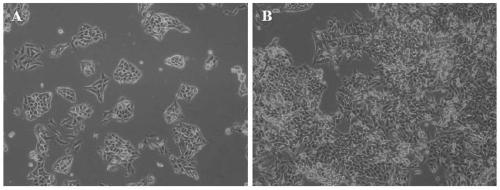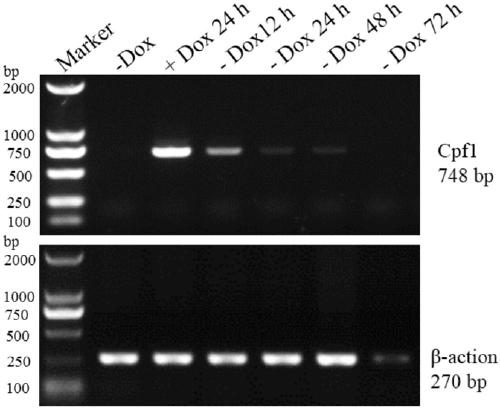Conditional inducible expression AsCpf1 lentiviral vector, construction method thereof and application to pig small intestine epithelial cell line construction
A technology of lentiviral vector and induced expression, which is applied in the direction of gastrointestinal cells, virus/bacteriophage, retroRNA virus, etc., can solve the problems of limited application, and achieve the effect of simple operation and convenient use
- Summary
- Abstract
- Description
- Claims
- Application Information
AI Technical Summary
Problems solved by technology
Method used
Image
Examples
Embodiment 1
[0028] A method for constructing a conditionally induced expression of AsCpf1 lentiviral vector, which comprises the steps of:
[0029] 1) Digest the pCW-Cas9 vector with Nhe1 and Bamh1 to obtain a linearized Tet-on-3G lentiviral vector fragment with a length of 7595bp, such as figure 1As shown in A;
[0030] 2) Utilize primer 1 (sequence shown in SEQ ID NO1) and primer 2 (sequence shown in SEQ ID NO2), use the pLVX-AsCpf1 plasmid as a template to amplify the AsCpf1 gene to obtain an AsCpf1 gene fragment with a length of 4026bp, as shown in figure 1 As shown in B;
[0031] 3) Ligating the AsCpf1 gene fragment obtained in step 2) with the Tet-on-3G lentiviral vector fragment in step 1) by ligase, that is, constructing a Tet-on-3G-pLVX-AsCpf1 lentiviral vector with a length of 11585bp;
[0032] 4) Preliminary detection of the product obtained in step 3) with Nhe1 and Bamh1 double enzyme digestion, the detection results are as follows figure 1 As shown in C, the constructed Te...
Embodiment 2
[0034] A method for constructing a porcine small intestinal epithelial cell line that conditionally induces AsCpf1 expression, comprising the steps of:
[0035] 1) The Tet-on-3G-pLVX-AsCpf1 virus solution is obtained by packaging the Tet-on-3G-pLVX-AsCpf1 lentiviral vector with lentivirus. The specific lentivirus packaging scheme is as follows:
[0036] a. 293FT cell plating: one day in advance at 10cm 2 Cultivate 293FT cells in a culture dish, culture in 10% 293FT cell culture medium, and infect when the cell contact reaches 70-80%;
[0037] b. When infecting, take a clean 1.5mL centrifuge tube and add 300μL of DMEM, lentiviral packaging plasmids pSPAX2, pMD2.G and shuttle plasmid (pLVX-Tet-on-3G-AsCpf1), the usage of each plasmid is 3.5 μg, 10.4μg and 10μg, add 60μL Qiagen transfection reagent, mix well with a pipette gun, and let stand at 15~25℃ for 10~15min;
[0038] c. Wash the cells twice with PBS, add 6 mL of 10% 293FT cell culture medium, and add the mixture dropwise...
Embodiment 3
[0046] Example 3: Detection of conditionally induced expression of AsCpf1
[0047] The porcine intestinal epithelial cells conditionally induced the expression of AsCpf1 constructed in the above Example 2 were added with Dox 24h and stopped with Dox for 12h, 24h, 48h and 72h, RNA was extracted respectively, cDNA was synthesized, and the expression of AsCpf1 was analyzed by RT-PCR .
[0048] 1. Extraction method of total RNA from porcine small intestinal epithelial cells (Qiagen micro-extraction kit)
[0049] 1) For trace samples, add 80 μL of newly prepared lysate (lysate: 10 μL of mercaptoethanol in 1 mL of buffer RLT, prepared before use);
[0050] 2) Add 80 μL of 70% ethanol, mix with a pipette tip, do not centrifuge;
[0051] 3) Transfer the sample to the nucleic acid purification column provided in the kit, assemble a 2mL collection tube, cover it gently, centrifuge at 8000g for 15s, discard the breakthrough solution, and put it back into the collection tube;
[0052] ...
PUM
 Login to View More
Login to View More Abstract
Description
Claims
Application Information
 Login to View More
Login to View More - R&D
- Intellectual Property
- Life Sciences
- Materials
- Tech Scout
- Unparalleled Data Quality
- Higher Quality Content
- 60% Fewer Hallucinations
Browse by: Latest US Patents, China's latest patents, Technical Efficacy Thesaurus, Application Domain, Technology Topic, Popular Technical Reports.
© 2025 PatSnap. All rights reserved.Legal|Privacy policy|Modern Slavery Act Transparency Statement|Sitemap|About US| Contact US: help@patsnap.com



